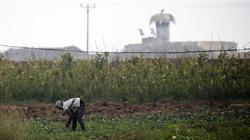 Israeli planes have reportedly sprayed toxic chemical substances and dangerous pesticides on farmlands near the Gaza Strip as the Tel Aviv regime presses ahead with its acts of aggression against the besieged Palestinian coastal enclave.
Israeli planes have reportedly sprayed toxic chemical substances and dangerous pesticides on farmlands near the Gaza Strip as the Tel Aviv regime presses ahead with its acts of aggression against the besieged Palestinian coastal enclave. RNA - Israeli newspaper Haaretz reported on Wednesday that the Israeli army sprayed the area in close proximity to the fence separating the Gaza Strip from the Israeli-occupied territories for three days last week.
The report added that the Israeli ministry of military affairs has defended the aerial spraying after having refrained from it throughout last year, claiming that it was necessary to destroy “vegetation that obscures soldiers’ view of the area.”
According to the Palestinian Agriculture Ministry, Israeli pesticides damaged 14,000 dunams (3,459 acres) of agricultural land in Gaza from 2014 through 2018, destroying all the crops that had been sown there.
Palestinian farmers told Haaretz that 2019 was an excellent year for them as there was no spraying.
Three human rights organizations, namely Gisha, Adalah and al-Mezan, immediately urged Israeli authorities to cease spraying after the practice resumed last week, saying there were “serious fears” that it had already harmed farmers in the area.
Anwar Jamali, a Gazan farmer, said he and his fellow farmers were given no advance notice of the spraying.
“In previous years, there was major damage. Sometimes dozens of dunams of wheat, barley and parsley were completely lost,” he said.
Jamali added that the stench of the pesticides causes people to leave the area if they can, “but barley can’t get up and leave.”
According to Palestinian farmers, while spraying is done on the Israeli-occupied territories, “the wind then carries the pesticides into Gaza.”
A Forensic Architecture report from 2019 confirmed Palestinian claims that the pesticides spread into Gaza, reaching a distance of more than 300 meters from the Gaza-occupied territories fence.
Gaza has been under Israeli siege since June 2007.
Since 2008, Israel has waged three wars against Gaza, where about two million Palestinians live under a 12-year Israeli blockade. Thousands of Gazans have been killed in each of these deadly wars.
847/940